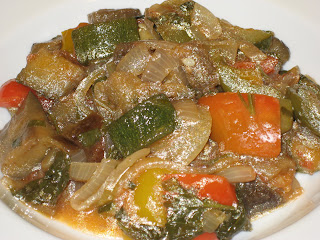
This is the first of three cookie posts. And with Christmas right around the corner, it seems like just about everyone is in a cookie-making mood.
The
current issue of Gourmet features an array of stunningly beautiful cookies including some
glittering lemon sandwich cookies that I can't wait to make. But the fine folks at
Gourmet didn't stop there, the editors and test kitchen cooks went through the archives to compile a
web feature of the best cookie recipe from the magazine for each year since 1941. I can't think of a more mouth-watering way to spend a half hour than to scroll through these sixty-plus recipes. Well, it didn't take long for a few intrepid food bloggers to see
Gourmet's cookie-of-the-year feature as a challenge. And thus,
The 12 Cookies of Christmas: A Gourmet Cookie Extravaganza was born. I'm looking forward to catching up on the efforts of Sandy from
At the Baker's Bench and her friends who decided to pick and make their 12 favorite recipes from Gourmet's "best of" collection. (Hat tip to Michelle of
What Does Your Body Good? for pointing me to the Extravaganza.)
OK, enough about other people's cookies. I want to talk about
my cookies. I volunteered to make some cookies for my church's bake sale. I picked
this recipe because I could make the cookies ahead of time, since, according to the Cook's Note, the cookies keep up to three weeks. In theory, this is a pretty easy recipe. The Book says that the start-to-finish time is 2 1/4 hours. But because I tend to make my own problems, and bite off more that I can chew, it took me about eight hours, over the course of three days to make these cookies. My downfall was reading The Book's suggestion of turning the cookies into ornaments and thinking, "That sounds like a good idea!" They came out great, but it took
forever to make them.
The cookie dough is pretty easy to make. First, I combined some molasses, brown sugar and spices (ginger, cinnamon, allspice and cloves) in a saucepan and brought it to a boil. Right from the first step, this recipe fills the house with an instant Christmas aroma. Off to a great start! Next I added the baking soda, and like an elementary school science project, the mixture foamed up furiously. (Good thing The Book warned me that was going to happen.) Then I added butter, an egg and the flour and mixed it right in the pan until I had a big ball of cookie dough.
I turned the dough out onto my baking mat and kneaded it for a little while. Then I put half of the dough into the refrigerator while I worked on the other half of the dough. I rolled the dough out nice and thin, and cut out as many snowflakes as I could. I rerolled the leftover dough to cut out more cookies, and then I rerolled it a few more times until I made all of the cookies I could. The Book says to reroll the dough once, presumably because it could get tough if it's rolled too many times. But I took my chances since I didn't want to waste any dough. All of the cookies I tasted were great, so I don't think that the multiple rollings did any harm.

To make the cookies into ornaments, I poked a hole in each cookie with a drinking straw before I put them in the oven. After the cookies cooled, I threaded a thin red or green ribbon through the hole and tied it in a bow. This was very tedious, and about halfway through the four dozen cookies the recipe yielded, I was rethinking the wisdom of making cookie ornaments.

Next came the decoration.
This recipe for decorating icing is a sub-recipe to the cookie recipe. It's pretty easy. Just combine a box of confectioner's sugar, powdered egg whites, water, lemon juice and vanilla extract. I didn't know that powdered egg whites existed, but I'm glad that they do, because the egg whites are necessary to give the icing its structure and stiffness, but I'd be nervous about using uncooked egg whites in cookies destined for a church bake sale. I can see it now: "Parishioner sickens dozens of churchgoers with salmonella-laced snowflake cookies. Film at eleven."

I opted for a pretty simple, less-is-more approach to decorating the cookies. There was more than enough icing to completely cover the cookies. But, I decided that because of my limited time, and my limited skills with a pastry bag, I'd keep it basic. Some might disagree, but I actually thought that the cookies were better for it. The cookies, as cookies, were delicious in their own right. Nice and crispy on the outside and chewy on the inside with a really nice mix of holiday spices. Exactly what you'd want in a gingerbread cookie. The icing, on the other hand, while sweet, was pretty blah, even with the lemon juice and vanilla. So, by keeping the decoration to a minimum, the cookies were able to shine whithout being overwhelmed by too much icing.
After the icing hardened, I put each of the cookies in an individual plastic bag fastened with a silver twist-tie. Again, about an hour into this part of the process, I was asking myself exactly why I though that it would be a good idea to do this way. In the end, the cookies were beautiful and delicious, if I do say so myself. I'd make this recipe again, but without all of the unnecessary fuss of making them into ornaments.
Date Cooked: November 30 - December 3, 2008
Degree of Difficulty: Medium (but VERY time consuming)
Rating: B
 We usually spend Christmas day with my wife's family. This year, my sister came up with the great idea of doing Christmas a little early with my side of the family. So, a little more than a week before Christmas, I had my grandparents and my sister and her family over for a holiday brunch.
We usually spend Christmas day with my wife's family. This year, my sister came up with the great idea of doing Christmas a little early with my side of the family. So, a little more than a week before Christmas, I had my grandparents and my sister and her family over for a holiday brunch.


















 Cute, cartoon rodents
Cute, cartoon rodents














